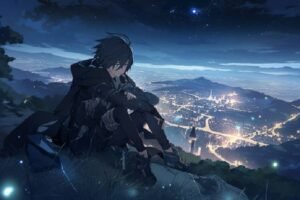Anime art is an attractive and obvious form of visual storytelling that has earned huge popularity worldwide. Originating in Japan, anime has developed into a various and influential art style, characterized by colourful visuals, expressive characters, and fantastical worlds. however, Let’s explore the key elements and the impact of anime art.
History of anime art
however, the roots of anime can be traced back to early Japanese art forms such as ukiyo-e prints and theatrical performances. The concept of animated images found its way into Japan from the West. Japanese animators experimented with animation techniques inspired by Western cartoons. The earliest known Japanese animation is “Namakura Gatana,” created by Junichi Kouchi in 1917.
Features of Anime art
- Unique Aesthetics: Additionally, Anime is instantly recognized for its unique aesthetics like featuring characters with large, expressive eyes, vibrant hair colours, and exaggerated facial expressions. This typical style allows for a wide range of emotions to be conveyed effectively.
- Diverse Genres: However, from action-packed shonen series to emotionally resonant shojo stories, and from fantastical adventures to slice-of-life narratives, anime covers a vast array of genres. This diversity in storytelling allows for a broad appeal, catering to audiences of all ages and interests.
- Fluid Animation: Unlike some Western animation styles, anime often prioritizes fluidity in animation. This emphasis on movement contributes to dynamic action sequences and visually engaging storytelling.
- Symbolism and Imagery: Anime frequently incorporates symbolism and metaphorical imagery, adding depth to the narrative. Colours, motifs, and visual cues are often used to convey emotions, themes, and character traits. Global Impact
- Cultural Exchange: In fact, Anime has become a global phenomenon, transcending cultural boundaries. Its popularity has led to a rich exchange of ideas and artistic influences between Japan and the rest of the world. Many international artists draw inspiration from anime in their works.
- Fandom and Community: However, the passionate anime community plays a crucial role in the art form’s global success. Conventions, fan art, and online discussions create a sense of camaraderie among fans worldwide, fostering a shared appreciation for the art and its impact on storytelling.
- Industry Trends: The anime industry has faced challenges such as tight schedules and production constraints. However, technological advancements have enabled improvements in animation quality, contributing to the evolution of the medium.
- Digital Innovation: However, The transition from traditional hand-drawn animation to digital techniques has allowed for greater production efficiency. Digital tools have opened up new possibilities for artists, leading to innovative and visually stunning anime productions.
Anime AI generator
Character Generation:
The AI could analyze popular anime character designs and generate unique visuals, including hairstyles, eye shapes, clothing styles, and accessories. However, incorporating personality traits into character creation, the AI might use algorithms to determine character backstories, quirks, and motivations, ensuring a diverse and interesting cast
Storyline Creation:
By understanding different anime genres, the AI could generate plot ideas tailored to specific categories, whether it’s action, romance, fantasy, or slice of life. Moreover, AI could develop compelling conflicts and resolutions, ensuring a balance of tension, emotional engagement, and satisfying conclusions.
Art Style:
Artists could input preferences for specific art styles, and the AI would adapt its visual output accordingly, allowing for a wide range of artistic interpretations. The AI might suggest dynamic scene compositions and framing inspired by successful anime series, enhancing the overall visual appeal.
Episode Scripting:
However, Using natural language processing, the AI could create authentic-sounding dialogue, considering the personalities and relationships of the characters. Analyzing pacing from existing anime episodes, the AI might determine the optimal balance between action, drama, and comedic moments for each episode.
User Interaction:
Users could have the ability to customize generated characters, story elements, or art styles to tailor the output to their preferences. The AI could learn and improve over time by incorporating user feedback and adapting to evolving trends and preferences in the anime community.
Benefits of Anime Art
Creativity and Expression:
Anime art allows creators to express their unique styles and ideas, fostering creativity and individuality. The diverse and often fantastical character designs in anime provide endless possibilities for imaginative expression.
Cultural Exploration:
Anime often reflects aspects of Japanese culture, providing viewers with an opportunity to explore and appreciate different traditions, customs, and aesthetics.
Global Community:
Anime has a vibrant and global fanbase, fostering a sense of community through conventions, online forums, and social media. This shared interest creates connections across cultures and borders.
Emotional Connection:
Moreover, Anime is known for its emotionally resonant storytelling, creating strong connections between characters and viewers. The expressive art style enhances the emotional impact of scenes, making it easier for audiences to connect with the characters and narrative.
Inspiration and Influence:
Anime artists often draw inspiration from each other, creating a dynamic cycle of creativity and innovation. Anime has influenced various art forms globally, from Western cartoons to fashion and contemporary art.

Conclusion
in the end, Anime art stands as a demonstration of the power of visual storytelling and artistic expression. Its global impact, unique aesthetics, and diverse storytelling have left an indelible mark on the world of entertainment. As the medium continues to evolve, anime art remains a dynamic and influential force, captivating audiences and inspiring artists around the globe.
